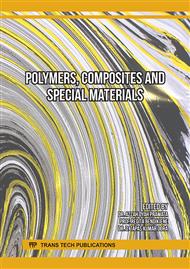[1]
A. Piontek, O. Vernaez, S. Kabasci, Compatibilization of poly(lactic acid) (PLA) and bio-based ethylene-propylene-diene-rubber (EPDM) via reactive extrusion with different coagents, Polymers 12 (2020) 605.
DOI: 10.3390/polym12030605
Google Scholar
[2]
P. Juntuek, C. Ruksakulpiwat, P. Chumsamrong, Y. Ruksakulpiwat, Effect of glycidyl methacrylate-grafted natural rubber on physical properties of polylactic acid and natural rubber blends, J. Appl. Polym. Sci. 125 (2012) 745-754.
DOI: 10.1002/app.36263
Google Scholar
[3]
K. Hamad, Y.G. Ko, M. Kaseem, F. Deri, Effect of acrylonitrile–butadiene–styrene on flow behavior and mechanical properties of polylactic acid/low density polyethylene blend, Asia-Pac. J. Chem. Eng. 9 (2014) 349-353.
DOI: 10.1002/apj.1802
Google Scholar
[4]
M. Siccardi, X.X. Garcia‑Fonte, A. Simon, V. Pettarin, M.J. Abad, C. Bernal, Effect of the processing‑induced morphology on the mechanical properties of biodegradable extruded films based on poly(lactic acid) (PLA) blends, J. Polym. Environ. 27 (2019) 2325-2333.
DOI: 10.1007/s10924-019-01512-0
Google Scholar
[5]
J.T. Yeh, C.H Tsou, C.Y. Huang, K.N. Chen, C.S. Wu, W.L. Chai, Compatible and crystallization properties of poly(lactic acid)/poly(butylene adipate-co-terephthalate) blends, J. Appl. Polym. Sci. 116 (2010) 680-687.
DOI: 10.1002/app.30907
Google Scholar
[6]
R. Jaratrotkamjorn, C. Khaokong, V. Tanrattanakul, Toughness enhancement of poly(lactic acid) by melt blending with natural rubber, J. Appl. Polym. Sci. 124 (2012) 5027-5036.
DOI: 10.1002/app.35617
Google Scholar
[7]
B. Xue, H.Z. He, Z.X. Huang, Z. Zhu, F. Xue, S. Liu, B. Liu, Fabrication of super-tough ternary blends by melt compounding of poly(lactic acid) with poly(butylene succinate) and ethylene-methyl acrylate-glycidyl methacrylate, Composites Part B 172 (2019) 743-749.
DOI: 10.1016/j.compositesb.2019.05.098
Google Scholar
[8]
D. Wu, L. Yuan, E. Laredo, M. Zhang, W. Zhou, Interfacial properties, viscoelasticity, and thermal behaviors of poly(butylene succinate)/polylactide blend, Ind. Eng.Chem. Res. 51 (2012) 2290-2298.
DOI: 10.1021/ie2022288
Google Scholar
[9]
S. Jia, J. Qu, R. Chen, C. Wu, Z. Huang, S. Zhai, W. Liu, Y. Feng, Effects of thermoplastic polyurethane on the properties of poly(lactic acid)/organo-montmorillonite nanocomposites based on novel vane extruder, Polym. Eng. Sci. 54 (2014) 2292-2300.
DOI: 10.1002/pen.23781
Google Scholar
[10]
M.M.F. Ferrarezi, M. de Oliveira Taipina, L.C.E. da Silva, M. do Carmo Gonçalves, Poly(ethylene glycol) as a compatibilizer for poly(lactic acid)/thermoplastic starch blends, J. Polym. Environ. 21 (2013) 151-159.
DOI: 10.1007/s10924-012-0480-z
Google Scholar
[11]
D. Kugimoto, S. Kouda, M. Yamaguchi, Improvement of mechanical toughness of poly(lactic acid) by addition of ethylene-vinyl acetate copolymer, Polym. Test. 80 (2019) 106021.
DOI: 10.1016/j.polymertesting.2019.106021
Google Scholar
[12]
Y. Feng, Y. Hu, J. Yin, G. Zhao, W. Jiang, High impact poly(lactic acid)/poly(ethylene octene) blends prepared by reactive blending, Polym. Eng. Sci. 53 (2013) 389-396.
DOI: 10.1002/pen.23265
Google Scholar
[13]
H. Eslami, M.R. Kamal, Elongational rheology of biodegradable poly(lactic acid)/poly[(butylene succinate)-co-adipate] binary blends and poly(lactic acid)/poly[(butylene succinate)-co-adipate]/clay ternary nanocomposites, J. Appl. Polym. Sci. 127 (2013) 2290-2306.
DOI: 10.1002/app.37928
Google Scholar
[14]
H. Torabi, A.R. SaadatAbadi, Property investigation of poly (ethylene co‑vinyl acetate)/poly(l‑lactic acid)/organo clay nanocomposites, J. Polym. Environ. 27 (2019) 2886-2894.
DOI: 10.1007/s10924-019-01558-0
Google Scholar
[15]
M. Nofar, M.C. Heuzey, P.J. Carreau, M.R. Kamal, Effects of nanoclay and its localization on the morphology stabilization of PLA/PBAT blends under shear flow, Polymer 98 (2016) 353-364.
DOI: 10.1016/j.polymer.2016.06.044
Google Scholar
[16]
T. Baouz, F. Rezgui, U. Yilmazer, Ethylene-methyl acrylate-glycidyl methacrylate toughened poly(lactic acid) nanocomposites, J. Appl. Polym. Sci. 128 (2013) 3193-3204.
DOI: 10.1002/app.38529
Google Scholar
[17]
M. Bijarimi, S. Ahmad and R. Rasid, Mechanical, thermal and morphological properties of poly(lactic acid)/natural rubber nanocomposites, J. Reinf. Plast. Compos. 32 (2013) 1656-1667.
DOI: 10.1177/0731684413496487
Google Scholar



